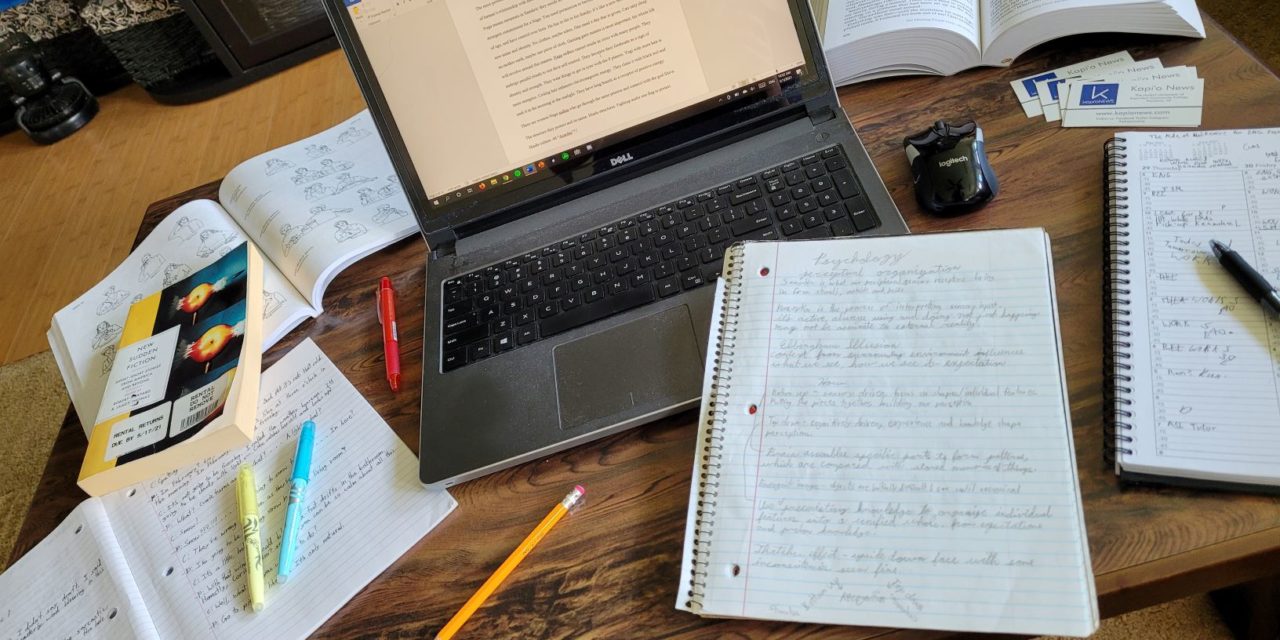by Nicklas Matsumoto | Staff Writer
Today marks the beginning of the last week of the semester, leading up to finals week from May 10-14. But finals may look different from class to class. I have had a couple of years of experience at KapCC and have compiled a list of tips for each unique final that may prove to be helpful for students trying to make it through the next couple of weeks.
Exam
Many classes have had exams throughout the semester, and the final exam usually resembles the prior exams. It is key to keep in mind the format and type of questions on the previous exams. This may reveal what to study and review. Video lectures accompanied by slides have been abundant over the past year, so don’t overlook them if they are available.
Don’t spend too much time on one question. Move on to other questions that are more familiar, then return to the ones that demand more time. Pay attention to the rules of the exams because some will not allow you to go back to previous questions to change the answer.
Paper
Consider crafting papers in separate parts: notes, outline, and draft. The notes section will contain all potentially useful information, and it may contain a research portion designated to what was found through various resources. The outline consists of bullet points with a title of the paragraph or a one-sentence summary of what will be covered in it. Rearranging the structure of the paper is much easier and makes it easier to keep track of what is covered in each section. The draft should be used as a way to get everything on paper roughly in comfortable order.
Improve the final draft by looking for words to replace with stronger, more descriptive words. Just take the word and search up its synonyms and pick the most appropriate option. Instead of, “The Egyptians made the pyramids.” Say, “The Egyptians constructed the pyramids.”
Presentation/Speech
Ask, “What is mentioned first, and how does it lead into the next thing?” This will keep the presentation organized and moving smoothly. To assist this process, imagine a house. The introduction would be the threshold, then determine what’s in the next room (perhaps you can cover why the presentation is relevant), and lead everything out of the house for the conclusion to view the house as a whole. If another illustration works more comfortably, then use it and adjust it as needed.
Most people are fine when it comes to reciting information, but it’s the transition to the next topic or important matter that gets tricky. Find common ground between the current topic and the one to follow. If the presentation is about various fictional characters and their different personalities, for example. When moving from one character to the next, mention what those two characters have in common, the types of relationships they have in common, if they experienced similar circumstances, the kind of world they live in, or even what you like about them. Just forming some kind of bridge could make the presentation flow much better.
Project/Portfolio
Organization and presentability are important factors in a portfolio. Focus on making it look clean and appealing. Decide on a theme and use it consistently with each individual piece, so it looks like they all belong together.
Once everything is assembled, carefully look over it again. Confirm that everything properly carries out its intended purpose. Look for anything that is out of place, distracting, or not assisting in achieving the goal of the project.
Course Review
Review notes and other resources that were emphasized throughout the course. Focus on tying in key lessons and making them personal. Mention what it means personally and how you connect with it.
Think about what the course did for you or why you were able to relate to the material. Even if it seems insignificant if it sticks out, focus on why.
General
Beware of the barrier of perfectionism. Don’t lose too much time focusing on one error, unless everything else is fine. Also, remember what corrections the professor has made. What have they focused on and emphasized? Incorporating those items may stand out to them more than other things.
Refrain from excessive experimentation. The entire semester was available for taking risks and trying out various methods. Now is the time to reflect on what worked and what didn’t, and then apply those methods accordingly.






